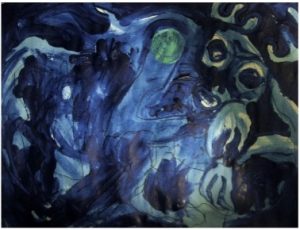Further Media Resources
- “Manidou Giizis – Waubgeshig Rice”: A video interview with Rice by Mohawk-Tuscarora poet Janet Marie Rogers that incorporates Anishinaabe teachings (courtesy of Debbie Beach Ducharme) and talk of Rice’s follow-up novel, Moon of the Turning Leaves.
- “Haunting the National Consciousness: The Rise of Indigenous Horror”: a video lecture by Oglala Lakota film scholar Kali Simmons, presented as part of the Fantasia International Film Festival held in Tiohtià:ke-Montréal-Mooniyang in August 2021. Simmons’ work traces the genre of Indigenous horror through pre-colonial, early colonial, and contemporary times, focusing primarily on film and popular culture.
- Wakening, a 2013 short film by Cree-Métis filmmaker Danis Goulet. Like Moon of the Crusted Snow, Goulet’s science fiction-horror film concerns Indigenous futures, eco-crises, and the wendigo, albeit from a Nêhiyaw and Métis rather than Ojibway cultural context.
Research and Discussion Activities
1. Reading Horror: In order to articulate my own point about horror and its “breaks” with the everyday in the introduction to this chapter, I caricatured a handful of classic horror stories like Jaws, Dracula, and Get Out into one-line synopses. If you had to write a similar one-line caricature (a simplified short description emphasizing dramatic features) of Moon of the Crusted Snow, which story elements would you choose to emphasize?
As a classroom or discussion activity, develop your own one-line caricature and then share it with others in a small group. What differences do you notice in how individual readers summarize the horror of Moon of the Crusted Snow? More pointedly, which aspects of the novel do the various members of your group point out as being especially scary or vital, and why? What can be learned from these differences?
2. Academic Research and Anishinaabe Storytelling: The story of the wendigo is an aspect of Ojibway culture that has been widely appropriated by settler media, from early colonial accounts to contemporary survival-horror video games. In contrast to these appropriations, Anishinaabe artists like Waubgeshig Rice have worked to restore and recontextualize the place of wendigo stories in contemporary Indigenous horror. In the “Acknowledgments” section at the end of Moon of the Crusted Snow, Rice explains that “The wendigo is a looming, often implicit figure in this story. The figure is hinted at, but its image doesn’t emerge until closer to the end” (217). He goes on to cite the sources that inform his depiction of the wendigo in the novel, including Ojibway writer Basil H. Johnston’s 1995 monograph The Manitous: The Spiritual World of the Ojibway.

Artistic depiction of the figure known as wendigo. “Wendigo” by Bill Rogers is licensed under CC BY-NC-ND 2.0.
Starting from the library database you use for research at your educational institution or in your community, search for scholarly sources on traditional wendigo stories (Johnston’s The Manitous might be a convenient place to start, even just as an index of possible search terms). While browsing for sources, consider some of the following questions:
- Who is the credited author of the source? What are their credentials as researchers? What is their relationship (if any) to the communities whose traditions they are representing? In what other ways can we measure the authority of a given source?
- In what ways do these sources relate to our primary field of interest: literary studies? Depending on their relevance or proximity to literary studies, how can you decide which sources are “useful” or not?
- How does the information available in these sources resonate and/or conflict with Waubgeshig Rice’s version of a wendigo story in Moon of the Crusted Snow? In what ways do their respective scholarly and literary approaches differ and overlap? In what ways are these two genres of text engaging with one another?
- Lastly, how do the wendigo stories in both the novel and your research connect with or contradict other versions of wendigo stories you may have encountered in popular media? Ask some of the questions in i-iii, except this time in regard to pop cultural wendigo stories. How do the answers differ, and what do these differences tell you about the authority and ethics of those pop cultural texts?
Works Cited
- Johnston, Basil. The Manitous: The Spiritual World of the Ojibway. Key Porter Books, 1995.








 ©
©